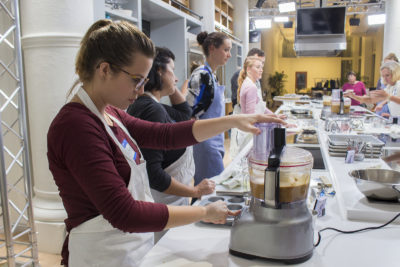
In a Milk Street cooking class on Wednesday, those in attendance were taught the importance of maximizing the essential ingredients of a recipe — something most college students who are strapped for cash and time can appreciate.
Rosemary Gill, the director of education and class leader, said the class “Less, but Better: Fewer Ingredients, More Impact” used interactive cooking and discussion to teach a method known as subtractive cooking.
“A short ingredient list can become a boring recipe or a spectacular one — and the difference is in knowing how to make the most of our time cooking,” Gill said.
Milk Street, located in downtown Boston at 177 Milk St., is a cooking school and headquarters for a magazine. Milk Street was founded by Christopher Kimball with the goal of bringing together international chefs to share cooking values, recipes, techniques and ideas.
This method of cooking focuses on using essential ingredients to create simple recipes without compromising flavor and taste, according to the event’s description. The primary technique of the “Less, but better” philosophy involves using various parts of one ingredient, mainly fresh produce, to bring forth new flavors and extract numerous nutritional benefits.
Jordyn Block, a senior in Boston University’s College of Communication, said she applies this method in her kitchen daily. Block runs a nutrition and wellness Instagram page called balancebyblock. Block said she often posts recipes with short ingredient lists and speaks highly of the nutritional benefits of subtractive cooking.
Moreover, Block said she has found that this philosophy allows her to get more bang for her buck when grocery shopping. She said subtractive cooking enables cooks to get a larger quantity of food, as well as more nutrients out of just one ingredient, rather than buying several ingredients and wasting valuable components.
“For example, in sweet potatoes, most of the fiber is in the skin. In salmon, a lot of the healthy fats are found in between the skin and the fish,” Block explained.
While students like Block choose to cook with a “less, but better” mindset to maximize nutritional benefits, others have less freedom.
Ella Tatum, a COM junior, said she has a myriad of allergies that prevent her from being able to use basic ingredients such as dairy, olive oil and gluten. Nonetheless, Tatum has always been an avid cook, and, with the help of subtractive cooking practices, is rarely inhibited by her allergies.
Consuming a diet of mainly fresh produce may sound boring to some, but even professional chefs outside of Milk Street have found that fewer ingredients can lead to a more maximized and satisfying plate.
“When you use less ingredients, your resourcefulness with that ingredient goes up,” explained Jared Goldberg, a School of Hospitality Administration sophomore. Goldberg said he’s worked in five different restaurants alongside an impressive list of notable chefs including Daniel Boulud, Geoffrey Zakarian and Ana Sortun.
He references a salad in which he used only four ingredients: fennel, orange, avocado and pomegranate. Using every part of each ingredient in a creative way not only simplified Goldberg’s shopping list, but also allowed for an innovative and mouthwatering meal.
“It ends up a simple dish that really brings forth certain flavors, rather than throwing a bunch of flavors on a plate and overwhelming the taste buds,” he said.
With time and practice, subtractive cooking can become more widespread. Whether it’s a college student struggling to find time for grocery shopping or a busy parent laboring over family dinner after a long workday, subtractive cooking can be very beneficial.
Gill said, “In the ‘Less, but Better’ class, we hope that students begin to understand that with just a few ingredients and the right know-how, a fabulous dinner can be made no matter how humble the ingredients are or pressed the cook’s time is.”















Always been my favorite way of cooking. When I see one with too many ingredients, I just skip the page.